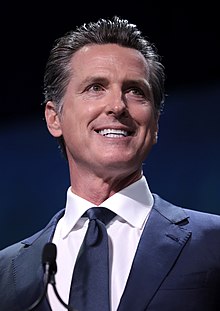Governor of California
The governor of California is the head of the state and government of the U.S. state of California and the commander-in-chief of the state's military forces. The governor is also the head of the executive branch of the state government and is the chairman of the gubernatorial cabinet.
| Governor of California | |
|---|---|
 Seal of the Governor of California | |
 Flag of the Governor of California | |
| Style |
|
| Type | Head of state Head of government |
| Member of | California Executive Branch California Cabinet |
| Residence | California Governor's Mansion |
| Seat | Sacramento, California California State Capitol (official workplace) |
| Appointer | Popular election |
| Term length | Four years, renewable once |
| Constituting instrument | Constitution of California |
| Inaugural holder | Peter Hardeman Burnett |
| Formation | December 20, 1849 |
| Deputy | Lieutenant Governor of California |
| Salary | $210,000 (annually) |
| Website | Official website |
Gavin Newsom is the 40th and current governor of California, in office since January 2019.
Powers and duties change
The governor has the power to enforce state laws and the duty to either approve or veto bills passed by the California Legislature or the California Senate to assemble the legislature and grant pardons, except in cases of impeachment.
Eligibility & requirements change
Section 5 of the state's constitution states for a person to serve as governor must:
- be at least eighteen years old.
- be a permanent resident in California and the United States for at least five years.
Election process and gubernatorial terms change
The governor is elected by the people through the popular election to a four-year term, along with the lieutenant gubernatorial candidate or the incumbent lieutenant governor of California as their running mate. The gubernatorial candidate or incumbent governor must have the majority of the popular vote in order to win the election.
Under Section 5 of the state's constitution forbids anyone from being elected governor more than twice.
Governor-elect of California change
The governor-elect is the candidate who has won the state's gubernatorial election and is awaiting inauguration to become the governor.
Inauguration change
The governor-elect, or incumbent governor immediately began their four-year team on inauguration day every four years in the month of January, along with the incumbent lieutenant governor and lieutenant governor-elect.
Gubernatorial line of succession change
If the governor dies, reigns, or is impeached, the lieutenant governor ranks first in the succession will assume the gubernatorial office and duties.
Residence change
The California Governor's Mansion is the official residence of the governor of California. It has been the official residence of every governor since 1903.
List of governors of California change
For the period before statehood, see list of governors of California before 1850. 1. Peter Burnett
3. John Bigler
5. John Weller
7. John Downey
10. Henry Haight
11. Newton Booth
12. Romualdo Pacheco
13. William Irwin
14. George Perkins
15. George Stoneman
17. Robert Waterman
19. James Budd
20. Henry Gage
21. George Pardee
22. James Gillett
23. Hiram Johnson
24. William Stephens
26. C. C. Young
27. James Rolph
28. Frank Merriam
29. Culbert Olson
30. Earl Warren
31. Goodwin Knight
32. Pat Brown
33. Ronald Reagan
34. Jerry Brown
36. Pete Wilson
37. Gray Davis
39. Jerry Brown
40. Gavin Newsom
